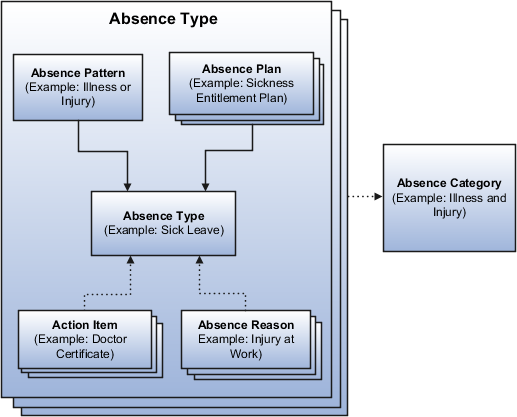How Absence Components Work Together
Configure absence components such as types, categories, patterns, plans, reasons, and certifications to reflect the absence management policy of your enterprise.
|
Component |
Location in the Absences Work Area |
|---|---|
|
Absence types |
Use the Absence Types task to create absence types. |
|
Absence categories |
Use the Absence Categories task to create absence categories and associate them with absence types. |
|
Absence patterns |
Review these settings on the Display Features tab when you create an absence type. |
|
Absence plans |
Use the Absence Plans task to create absence plans. |
|
Absence reasons |
Use the Absence Reasons task to create absence reasons. |
|
Absence certifications |
Use the Absence Certifications task to set up a requirement. Then associate the requirement as an action item with an absence type so that every absence associated with the absence type is subject to that requirement. |

Absence Type
When you create an absence type, such as sick leave, you include rules to determine when users record or manage an absence of that type. For example, you can restrict workers so that they can record absences only of a particular duration. An alert appears if the entered duration exceeds the maximum value.
Decide which fields or sections you want to show or hide for specific user roles when they record or approve a specific absence type.
Absence Category
Create absence categories to group absence types for reporting and analysis. For example, you can create an absence category called family leave and associate with it absence types, such as maternity, paternity, and child care.
Absence Pattern
An absence pattern contains a predefined set of rules that you can use as a starting point to create an absence type. When you create an absence type, you must associate it with any of the following predefined patterns:
-
Illness or injury
-
Childbirth or placement
-
Generic absence
For example, you can select the Generic absence pattern to create an absence type to schedule vacation time using the time accrued under a vacation accrual plan.
The pattern that you select determines:
-
Whether special fields appear on the absence type pages
-
The options available to display and process various aspects of absence recording
For example, the Childbirth or placement pattern displays a field for selecting whether the absence type applies for childbirth or adoption placement.
Absence Plans
Create absence plans to define rules for accruing leave time and receiving payments during an absence period. You must associate at least one absence plan with an absence type.
To schedule an absence using an absence plan, the unit of measure defined in the plan must match the unit of measure defined in the associated absence type. If the unit of measure differs, you can define the conversion formula and attach it to the absence type. This formula is applicable only if the unit of measure is hours or days for the absence type.
Absence Reasons
Create absence reasons to select from when scheduling an absence. Absence reasons are independent of absence types. You can use the same reason for multiple absence types. When you create an absence type, you associate the reasons with the type.
Absence Certifications
Create certification requirements for absences that require documentation to authorize an absence. For example, in case of an absence due to illness, set up a requirement that workers must submit a doctor's certificate within a stipulated period of time. This ensures they receive full payment for the absence duration.